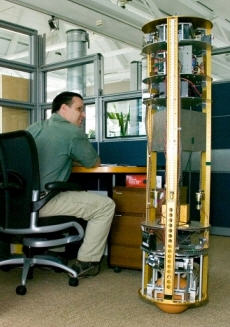I recently stumbled across this Adding Humor to Text-Based Applications paper (by Rada Mihalcea and Carlo Strapparava). What attracted me was this articulating humor and software engineering. This is the starting point:
given the importance of humor in our daily lives and computers in our work and entertainment, studies related to computational humor will become increasingly significant in fields such as human-computer interaction,intelligent interactive entertainment, and computer-assisted education. (...) Although scientific fields such as linguistics and psychology have studied humor relatively well to date, only a little research has addressed the construction of computational humor prototypes. (...) A system called JAPE (Joke Analysis and Production Engine) then exploited the model to automatically generate amusing puns. HAHAcronym, another humor-generation project, developed a system that automatically generated humorous versions of existing acronyms and produced a new amusing acronym constrained to be a valid vocabulary word.4The system achieved a comic effect mainly by exploiting incongruity theories (for example, finding a religious variation for a technical acronym).
The paper is mostly about the applicability to the recognition and use of verbally expressed humor ("Can we automatically gather large collections of humorous texts? Can we automatically recognize humor in text? And can we automatically insert humorous add-ons into existing applications? "). Why do I blog this? I did not go deeper in the user studies that (at first glance) seems pretty interesting because I was more interested by humor recognition and production. Especially if we think in terms of games, there is a lot to create here, and it's very difficult to go beyond bot practices. I like Animal Crossing's way of tuning people's expressions. In this game, you can teach funny hooks and expressions to the virtual inhabitants of the city you live in. There might be relevant use of humor model here to rely on private jokes and absurd situations.
 The list is aimed at describing "prevailing tendencies permeating research, product development and service design within the field of information technology" It "outlines the ten most commented, applied, discussed and "hot" tendencies right now".
Why do I blog this? even though I do agree with the facts that location-awareness applications are a hot trend in research and R&D (+ some prototypes have been shipped to the market), I am a bit skeptical about the applications described in this snippet. As I
The list is aimed at describing "prevailing tendencies permeating research, product development and service design within the field of information technology" It "outlines the ten most commented, applied, discussed and "hot" tendencies right now".
Why do I blog this? even though I do agree with the facts that location-awareness applications are a hot trend in research and R&D (+ some prototypes have been shipped to the market), I am a bit skeptical about the applications described in this snippet. As I 








 (picture by Evan Richman/Globe Staff)
(picture by Evan Richman/Globe Staff)




